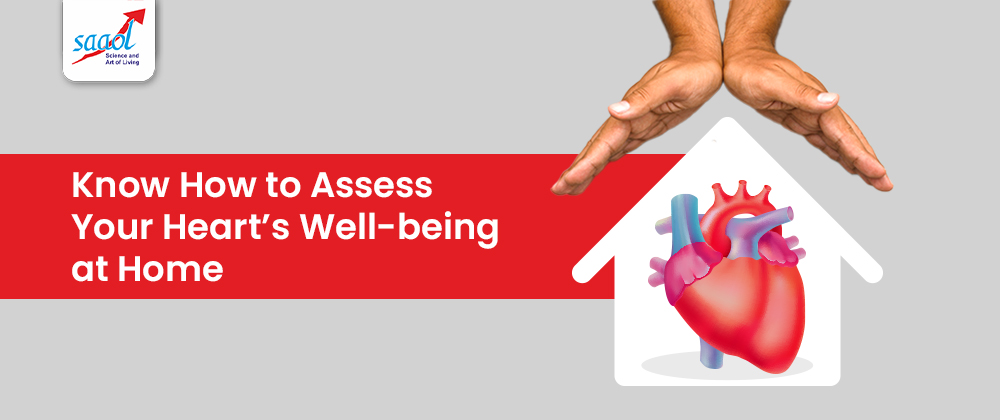Know How to Assess Your Heart’s Well-being at Home
SAAOL
- October 9, 2023
- 5 Min Read

In today’s fast-paced world, where hectic schedules often leave very little room for self-care, our heart health often gets neglected. However, your heart is your body’s engine, and its well-being is crucial for your overall health. Thankfully, there are ways to monitor your heart’s health from the comfort of your home.
This blog aims to empower you with the knowledge to take charge of your heart health proactively. We will delves into various aspects, from recognizing the subtle signs of heart issues, especially in women, to understanding the importance of lifestyle factors and home-based assessments, heart attack test online. While we need to keep in mind that these cannot replaced professional medical evaluations but they play a vital role in early detection and prevention.
So let’s move on to practical steps you can take to assess your heart’s well-being in the comfort of your home.
Recognizing the Signs: Symptoms of Heart Blockage in Females
When it comes to heart blockages and heart attacks, it’s crucial to recognize that they don’t discriminate by gender. While chest pain is a typical symptom for both men and women, females may experience heart attack symptoms differently. Some symptoms of heart blockage in females include:
1. Chest Discomfort
Just like men, women may feel chest discomfort like an elephant is sitting on their chest during a heart attack. However, it’s important to note that this discomfort can manifest as a squeezing, fullness, or pressure sensation rather than a sharp pain.
2. Pain in Other Areas
Women may experience discomfort or pain radiating to their neck, jaw, shoulder, upper back, or abdomen. These symptoms can be subtle and are often mistaken for digestion or muscle pain.
3. Shortness of Breath
Feeling out of breath, even without physical exertion, can be an indicator of heart trouble in women.
4. Fatigue
Unexplained and extreme fatigue is another potential sign of heart issues in females.
5. Nausea or Vomiting
Some women may experience nausea or vomiting, which can accompany other heart attack symptoms.
It becomes crucial to understand that these symptoms can vary widely among individuals, and not everyone will experience the same signs. If you notice any of these symptoms, especially if they persist or worsen, seeking immediate medical attention is well advised.
How to Check Heart Blockage at Home
While professional medical assessments are essential, there are several proactive steps you can take at home to monitor your heart health:
1. Know Your Numbers
Regularly measure your blood pressure and keep track of the results. High blood pressure (hypertension) is a significant risk factor for heart disease.
2. Monitor Your Heart Rate
Use a digital heart rate monitor or a fitness tracker to keep tabs on your resting heart rate. An unusually high or irregular heart rate may warrant further investigation.
3. Assess Your Lifestyle
Evaluate your diet, exercise routine, and stress levels. Maintaining a heart-healthy lifestyle can significantly reduce your risk of heart problems. Opt for a balanced diet, regular physical activity and effective stress management as much as you can.
4. Online Heart Attack Risk Calculator
Some reliable online tools estimate your heart attack risk based on factors like age, cholesterol levels, blood pressure, and smoking history. While not a definitive diagnosis, they can provide valuable insights and encourage further discussions with healthcare professionals.
5. Symptom Tracking
Keep a journal of any unusual symptoms, their frequency, and their severity. Sharing this information with your doctor can aid in diagnosis.
Home Tests for Heart Health
While at-home tests cannot replace professional medical evaluations, they can offer valuable insights as early warning signs:
1. Cholesterol Testing Kits
These kits are readily available and can help you monitor your cholesterol levels over time.
2. Blood Glucose Monitoring
If you have diabetes or prediabetes, regularly checking your blood glucose levels is crucial. Uncontrolled diabetes can lead to heart problems.
3. Blood Pressure Monitor
Invest in a reliable home blood pressure monitor to keep track of your blood pressure. Elevated blood pressure can strain your heart.
4. ECG or EKG Devices
Some smartphone apps and portable ECG devices can provide basic heart rhythm information or heart attack test online. Consult with your doctor on their use and interpretation.
By incorporating these assessments into your routine, you can become more aware of your heart’s heath and take action promptly if you notice any concerning changes.
Seeking Professional Guidance
While home assessments and tests can be super helpful, they are not a substitute for professional medical advice. If you suspect heart problems or have risk factors such as a family history of heart disease, it’s essential to consult with a healthcare provider. They can recommend the best tests and screenings to assess your heart’s health accurately.
It is important to remember that the most reliable diagnostic tests for heart problems, such as angiography or stress tests, should be conducted by medical professionals. They offer the most precise insights into your heart’s condition and can tailor treatments if necessary like SAAOL Heart Center.
If you want a comprehensive understanding of your heart health then SAAOL Heart Center is the best heart treatment center which offers expert consultation and treatment for heart disease.
Conclusion
Your heart is an invaluable asset, and safeguarding its health is a lifelong journey. By staying informed and proactive about your heart health, you can take significant steps towards maintaining a strong and healthy heart. Remember that professional guidance for heart health is essential for accurate diagnosis and treatment, so never hesitate to consult with experts when needed.
